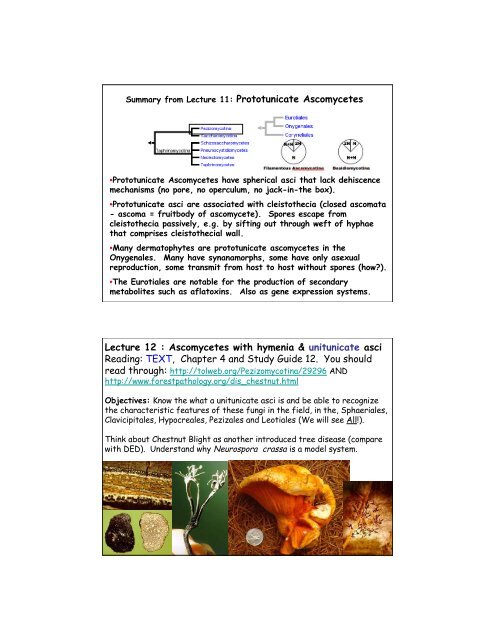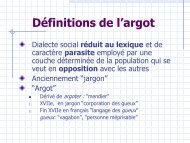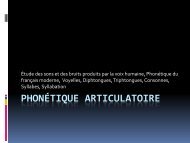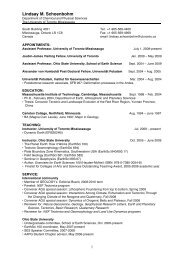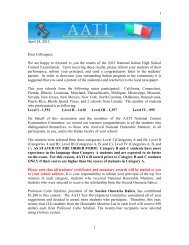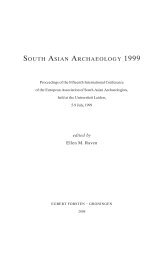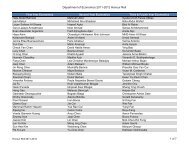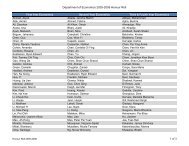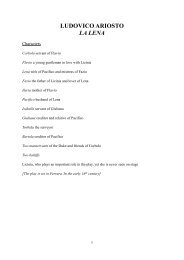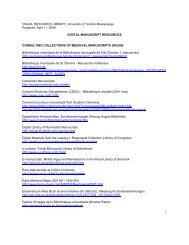Diatrype disciformis (Hoffm.) Fr.
Diatrype disciformis (Hoffm.) Fr.
Diatrype disciformis (Hoffm.) Fr.
You also want an ePaper? Increase the reach of your titles
YUMPU automatically turns print PDFs into web optimized ePapers that Google loves.
Summary from Lecture 11: Prototunicate Ascomycetes<br />
•Prototunicate Ascomycetes have spherical asci that lack dehiscence<br />
mechanisms (no pore, no operculum, no jack-in-the box).<br />
•Prototunicate asci are associated with cleistothecia (closed ascomata<br />
- ascoma = fruitbody of ascomycete). Spores escape from<br />
cleistothecia passively, e.g. by sifting out through weft of hyphae<br />
that comprises cleistothecial wall.<br />
•Many dermatophytes are prototunicate ascomycetes in the<br />
Onygenales. Many have synanamorphs, some have only asexual<br />
reproduction, some transmit from host to host without spores (how?).<br />
•The Eurotiales are notable for the production of secondary<br />
metabolites such as aflatoxins. Also as gene expression systems.<br />
Lecture 12 : Ascomycetes with hymenia & unitunicate asci<br />
Reading: TEXT, Chapter 4 and Study Guide 12. You should<br />
read through: http://tolweb.org/Pezizomycotina/29296 AND<br />
http://www.forestpathology.org/dis_chestnut.html<br />
Objectives: Know the what a unitunicate asci is and be able to recognize<br />
the characteristic features of these fungi in the field, in the, Sphaeriales,<br />
Clavicipitales, Hypocreales, Pezizales and Leotiales (We will see All!).<br />
Think about Chestnut Blight as another introduced tree disease (compare<br />
with DED). Understand why Neurospora crassa is a model system.
Tree of Life http://tolweb.org/Pezizomycotina/29296 is up-to-date and DNA sequence-based.<br />
We are still in the Pezizomycotina, but in new classes today. Your Text, The Fifth<br />
Kingdom presents a taxonomy based on ascus and ascoma (unitunicate inoperculate asci<br />
in perithecia, called Pyrenomycetes; or unitunicate asci, in apothecia, called<br />
Discomycetes in many texts). Unitunicate, operculate asci are only in the order Pezizales.<br />
Green arrow = lichenized<br />
Series Unitunicatae-Operculatae<br />
Order Pezizales: 150 genera, 900 species. The 'operculate discomycetes'<br />
-- Your TEXT looks at 7 of the 13 families currently recognized.<br />
Familiy Pezizaceae is the core of the Order: Their asci have a diagnostic pop-open<br />
lid or operculum, and the tips of the asci are amyloid (sometimes expressed as I+ -this<br />
means giving a blue, starch-like reaction in an iodine solution known as<br />
Melzer's reagent). Below right: evolution of hypogeous forms (the true Truffles):
Photo from Algonquin Park, BIO 335 trip, 2010: Operculate ascus –no “toilet” lid yet<br />
- Note tip of ascus is blue in Melzer’s reagent. See that ascus tip is thin.<br />
- Note 8 ascospores with reticulate walls, each contain 2 oil vacuoles.<br />
Order Pezizales (Pezizales is placed in order Pezizomycetes in<br />
Tree of Life), Family Morchellaceae<br />
Morel<br />
Choice Edible<br />
Verpa (left 2 photos)<br />
May be Poisonous<br />
Gyromitra infula<br />
Poisonous.<br />
Morel (right 2 photos)<br />
Choice Edible<br />
TEXT
Order Pezizales<br />
Family Tuberaceae - the truffles.<br />
The inoperculate ascus has a<br />
thick tip that is perforated by a<br />
pore (there is a hole through the<br />
tip). The pore wall may turn<br />
blue in Melzer’s reagent.<br />
Ascus (showing an apical perforation<br />
pore with the wall turning blue in<br />
iodine solution), paraphyses and<br />
ascospores of Mollisia ventosa. ©<br />
Hans-Otto Baral<br />
http://tolweb.org/Leotiomycetes<br />
The ascomata are closed, hypogeous and<br />
solid (no air spaces any more -- as you can<br />
see in this bisected specimen of Tuber<br />
aestivum, which a truffle dog brought to me<br />
at Scheggino in Italy)<br />
The asci, produced in a highly convoluted<br />
hymenium, are rounded and thin-walled<br />
(those of Tuber albidum are shown at left)<br />
with no trace of an operculum or other<br />
shooting mechanism, and usually contain<br />
only 1-3 spores. TEXT.
Order Leotiales: 13 families, 400 genera, 2000 species. The 'inoperculate<br />
discomycetes.' The apothecial ascomata are superficially similar to those of the<br />
Pezizales, but the asci are inoperculate, and usually have amyloid apical ring.<br />
Family Sclerotiniaceae (images from Prof. Kohn and TEXT).<br />
As the name implies, these fungi often form sclerotia, which may be solid<br />
masses of fungal tissue, or may be of mixed origin -- fungal hyphae riddling a<br />
mummified host such as a peach, plum or cherry, or a catkin (right). Having<br />
overwintered in this guise, they germinate in spring and use the stored energy<br />
to produce stalked apothecial ascomata (right). Ascospores are shot when the<br />
host is in flower, and gain entrance through the stigma.
Order Leotiales: Sclerotiniaceae.<br />
http://www.agf.gov.bc.ca/cropprot/tfipm/brownrot.htmt<br />
http://www.apsnet.org/education/LessonsPlantPath/BrownRo<br />
t/text/CYCLE.HTM Also TEXT<br />
Order Leotiales: Family Leotiaceae contains some more normal-looking<br />
'discomycetes' such as Bisporella, which produces those small yellow<br />
discoid apothecia so common on fallen, decorticated tree-trunks...<br />
Family Geoglossaceae - literally "earth-tongues"<br />
TEXT
http://www.naturefg.com/pages/fu-ascomycota.htm Nature Photography by Dragiša Savić<br />
Holwaya mucida is a Leotiales fungus with black, gelatinous, turbinate apothecia (sexual<br />
fruitbodies also called ascomata, singular is ascoma). The asexual stage is large also –<br />
note the white head is mucilaginous and contains numerous asexual conidia (mitospores).<br />
Amit Patel collected the anamorph (mitosporic, asexual state) at Algonquin Park.<br />
Tree of Life http://tolweb.org/Pezizomycotina/29296 is up-to-date and DNA sequence-based.<br />
We are still in the Pezizomycotina, but in new classes today. Your Text, The Fifth<br />
Kingdom presents a taxonomy based on ascus and ascoma (unitunicate inoperculate asci<br />
in perithecia, called Pyrenomycetes; or unitunicate asci, in apothecia, called<br />
Discomycetes in many texts). Unitunicate, operculate asci are only in the order Pezizales.<br />
Green arrow = lichenized
Order Sphaeriales: 225 genera, 1300 species.<br />
Dark, crusty, globose to pear-shaped individual perithecial<br />
ascomata with prominent ostioles.<br />
OR many perithecial cavities immersed in a single stroma to<br />
form a compound fructification, as in Xylaria below<br />
The asci often have an apical ring or sphincter, which is<br />
usually, though not always, amyloid (stains blue in iodine).<br />
Thread-like, sterile elements called paraphyses are present<br />
between the asci in the hymenium of some members, absent<br />
from others<br />
Ascospores can be light or dark, simple or septate, with or<br />
without germ pore or slit, sometimes with gelatinous sheaths or<br />
appendages.<br />
<strong>Diatrype</strong> <strong>disciformis</strong> (<strong>Hoffm</strong>.) <strong>Fr</strong>.<br />
http://www.bioimages.org.uk/html/P158449.HTM
Nature 422, 859 - 868 (24 April 2003); doi:10.1038/nature01554<br />
The genome sequence of the filamentous fungus<br />
Neurospora crassa<br />
Neurospora crassa is a central organism in the history of twentiethcentury<br />
genetics, biochemistry and molecular biology. Here, we<br />
report a high-quality draft sequence of the N. crassa genome. The<br />
approximately 40-megabase genome encodes about 10,000 proteincoding<br />
genes—more than twice as many as in the fission yeast<br />
Schizosaccharomyces pombe and only about 25% fewer than in the<br />
fruitfly Drosophila melanogaster. Analysis of the gene set yields<br />
insights into unexpected aspects of Neurospora biology including<br />
the identification of genes potentially associated with red light<br />
photobiology, genes implicated in secondary metabolism, and<br />
important differences in Ca2+ signalling as compared with plants<br />
and animals. Neurospora possesses the widest array of genome<br />
defence mechanisms known for any eukaryotic organism, including<br />
a process unique to fungi called repeat-induced point mutation<br />
(RIP). Genome analysis suggests that RIP has had a profound<br />
impact on genome evolution, greatly slowing the creation of new<br />
genes through genomic duplication and resulting in a genome with<br />
an unusually low proportion of closely related genes.<br />
Order Hypocreales: 80 genera, 550 species.<br />
This order is recognized by its brightly coloured, simple or compound,<br />
perithecial ascomata -- usually yellow, orange or red -- which are fleshy or<br />
waxy in texture, and usually borne on supporting layers of mycelium (subicula)<br />
or in stromata. Four genera are especially well-known.<br />
Nectria (27 spp) has bright red, superficial perithecia<br />
(right) containing 2-celled (didymosporous) ascospores.<br />
Some species cause cankers and die-backs of trees.<br />
Below: commonly encountered anamorph,<br />
Tubercularia, causes “coral spot”.Nectria species<br />
can cause cankers and die-backs of trees.
Order Hypocreales continued:<br />
The most economically important of the<br />
nectriaceous anamorphs are certain Fusarium<br />
specie), many of which cause destructive wilt<br />
diseases of higher plants, or produce mycotoxins.<br />
Gibberella also has Fusarium anamorphs, which<br />
are producing the reddish pigment seen in the<br />
picture<br />
The lower picture shows Gibberella (dark) and its<br />
Fusarium anamorph (reddish-orange) growing<br />
together on a corn cob.<br />
One species of Gibberella causes a disease of rice<br />
called 'foolish seedling' in which seedlings grow<br />
too rapidly and consequently fall over. The active<br />
principle, a plant growth hormone called<br />
gibberellic acid, has been extracted and is now<br />
widely used to stimulate plant growth.<br />
Order Hypocreales continued:<br />
TEXT<br />
Hypomyces lactifluorum, an orange fungus which,<br />
like other species of the genus, parasitizes<br />
basidiiomycetes, in this case the agaric genera<br />
Lactarius and Russula...<br />
Left: The ostiole is the opening of the perithecium.
Order Hypocreales continued:<br />
Hypocrea forms fleshy stromata on wood<br />
(LEFT). The dark spots are the ostioles of the<br />
embedded perithecial cavities.<br />
The teleomorph of Hypocrea is recorded far less<br />
often than its green-spored, phialidic<br />
anamorph, Trichoderma (lower right) which,<br />
because it is a broad-spectrum mycoparasite,<br />
and produces cellulases and antibiotics, is one of<br />
the most important moulds in forest soils. Used<br />
in biological control of pathogenic fungi and<br />
for production of enzymes which can convert<br />
cellulose to glucose.<br />
Order Clavicipitales: 27 genera,<br />
270 species.<br />
Sophisticated, obligate parasites:<br />
(a) frequently stalked, all-fungal<br />
stromata (below, A,B,D,E), (b)<br />
long asci without apical rings, but<br />
with thickened tips (below, right,<br />
F), and (c) long, thread-like<br />
ascospores that in some taxa<br />
fragment at or following release<br />
(below, right, F). TEXT.<br />
Trichoderma viride<br />
(anamorphic fungus)<br />
TEXT and:fungus)<br />
http://www.bioimages.org.uk/HTML/<br />
P164979.HTM
Chestnut Blight Disease<br />
Contributed by<br />
Sandra L. Anagnostakis<br />
Connecticut Agricultural Experiment Station<br />
Box 1106<br />
New Haven, CT 06504<br />
Phone 203-974-8498<br />
Sandra.Anagnostakis@po.state.ct.us<br />
Figure 1. An American chestnut stem with a chestnut blight canker. (Click image for larger view and more information).<br />
Chestnut blight, or chestnut bark disease, is caused by an introduced fungus, Cryphonectria parasitica<br />
(Murrill) Barr, (formerly Endothia parasitica [Murrill] Anderson & Anderson). The fungus enters wounds,<br />
grows in and under the bark (Fig. 1), and eventually kills the cambium all the way around the twig,<br />
branch, or trunk (33). Sprouts develop from a burl-like tissue at the base of the tree called the ‘root<br />
collar,’ which contains dormant embryos (39). Sprouts grow, become wounded and infected, and die, and<br />
the process starts all over again.<br />
Cankers were first reported in the United States in 1904 on American chestnut trees (Castanea dentata<br />
[Marshall] Borkhausen) (Fig. 2) in New York City (32). None of the control attempts (chemical treatments,<br />
clearing and burning chestnut trees around infection sites) were successful (47). By 1926 the fungus was<br />
reported throughout the native range of American chestnut (Fig. 3), and a major forest tree had been<br />
reduced to a multiple-stemmed shrub (17). In 1912 the Plant Quarantine Act was passed to reduce the<br />
chances of such a catastrophe happening again (49).<br />
Fig. 1<br />
Fig 3<br />
Fig. 1. An American chestnut stem with a chestnut blight canker (Castanea dentata with a<br />
Cryphonectria parasitica canker). The fungus enters through wounds such as the broken branch<br />
stub on the left, and grows in and under the bark, killing the cambium. Fungal stromata break<br />
through the lenticels and pycnidia producing conidia and perithecia producing ascospores are<br />
formed. Photo by R. A. Jaynes.<br />
Fig. 2. An American chestnut tree (Castanea dentata [Marshall] Borkhausen) growing in Scotland,<br />
Connecticut in 1905. The tree was 83 feet tall, 27 inches in diameter, and 103 years old.<br />
Figure 3. The natural range of American chestnut as presented by Saucier in 1973<br />
http://www.apsnet.org/online/feature/chestnut/top.html<br />
Fig. 2
Tree of Life http://tolweb.org/Pezizomycotina/29296 is up-to-date and DNA sequence-based.<br />
We are still in the Pezizomycotina, but in new classes today. Your Text, The Fifth<br />
Kingdom presents a taxonomy based on ascus and ascoma (unitunicate inoperculate asci<br />
in perithecia, called Pyrenomycetes; or unitunicate asci, in apothecia, called<br />
Discomycetes in many texts). Unitunicate, operculate asci are only in the order Pezizales.<br />
Green arrow = lichenized<br />
Ascoma<br />
(teleomorph)<br />
Ophiostoma ulmi causes<br />
Dutch Elm Disease.<br />
Hair-like hyphae at the top<br />
Of ascoma.<br />
Graphium anamorph Synnemata.<br />
Sporothrix anamorph<br />
Order Ophiostomatales (Sordariomycetes in Tree of Life): 15 genera, 130 species.<br />
Ascomata have long, tubular necks, with the ostiole at the tip. The asci are not<br />
arranged in a hymenium, and autolyse early. The spores ooze out of the ostiole and<br />
form a slimy droplet that is supported by a ring of specialized, hair-like hyphae at<br />
the top of the neck.These fungi often fruit in bark beetle tunnels - elevated spore<br />
drop ensurse beetle carries spores with it when it flies off in search of another tree.<br />
Ophiostoma ulmi, my example of the Ophiostomatales, has a Graphium anamorph<br />
that produces many conidiomata each bearing a slimy droplet of conidia at its tip -<br />
anamorph is completely analogous to the teleomorph; both ensure that beetles<br />
don't leave home without them. Another anamorph, Sporothrix, produces conidia<br />
and yeast cells in tree xylem, releasing wilt toxin, cerato-ulmin. FROM TEXT.
Plant Disease Lessons: http://www.apsnet.org/Education/LessonsPlantPath/DutchElm/top.htm<br />
As early as June, the leaves on a DED-infected elm<br />
will wilt, turn yellow, then curl and turn brown.<br />
Symptoms usually first appear in the crown on the<br />
tree, and can be seen until fall colours appear.<br />
Dutch elm disease is spread by the native elm bark<br />
beetle which can fly up to 2 km as it searches for<br />
healthy elms to feed on. The DED fungus has sticky<br />
spores that become attached to the beetle during<br />
its breeding period. The beetle then spreads the<br />
fungus when it feeds on and over-winters in healthy<br />
elms.<br />
Do not prune your elms between April 13th and July<br />
31st. The Elm Bark Beetle that spreads the DED<br />
fungus is attracted to freshly cut elm and is most<br />
active during this period.<br />
http://www.sdeda.ca/what_is.html<br />
http://www.fs.fed.us/na/morgantown/fhp/palerts/ded/elm.htm
DED early symptoms:<br />
Yellowing of leaves in<br />
crown.<br />
http://www.sdeda.ca/what_is.html<br />
DED symptoms: brown discoloration of xylem.


